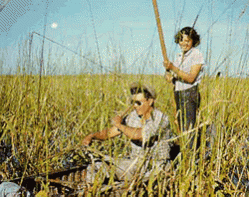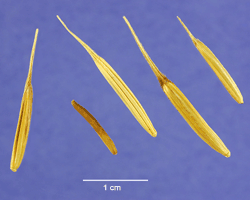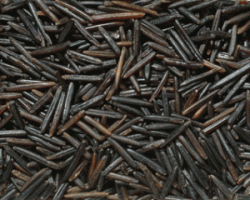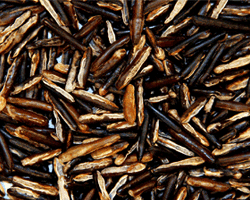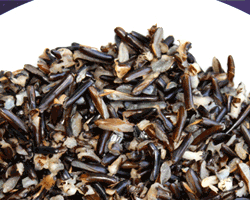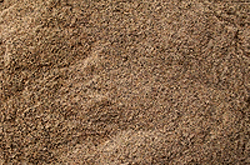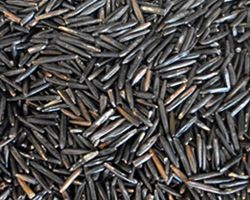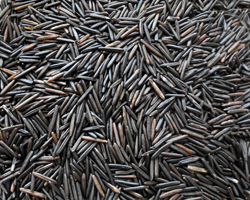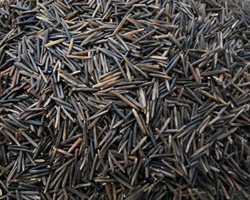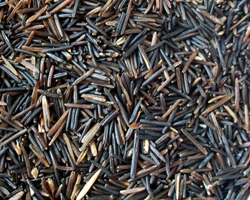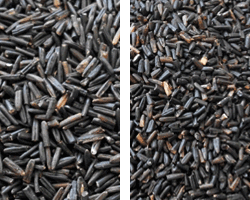Wild Rice has a bold, dark color and a slender, elongated shape – and like all grains, it can also be ground into flour.
|
Harvesting Natural Wild Rice In the Great Lakes region, Native Americans still harvest wild rice in the same traditional ways their ancestors have done for thousands of years. Wild rice is deeply respected as a sacred gift from the earth. |
|
|
Wild Rice Hulls, Close-up This photo shows four wild rice seeds, or kernels, still in their inedible hulls, and one seed removed from its hull. |
|
|
Wild Rice Grains This photo shows wild rice before it’s cooked. See below, for more photos.
|
|
|
Quick-Cook Wild Rice Like most other slow-cooking whole grains, wild rice is now available in quick-cooking versions, making it convenient no matter how much time you have to cook. Because it’s partially pre-cooked, Quick-Cook Wild Rice can be ready and on the table in as little as five minutes. |
|
|
Wild Rice, Cooked Cooking makes the slender grains burst open, showing the lighter-colored interior. |
|
|
Wild Rice Flour Yes, wild rice can be ground into a delicioius gluten-free flour and used to bake other foods. (Yes, it’s right there on Amazon. Who knew?) A warm tan in color, wild rice flour is best used when mixed with other flours, in breads, muffins, pancakes, waffles and cookies. |
Photo credits above (from top):
USDA (Native harvest and grains close-up); Lundberg Family Farms (wild rice grains); Goose Valley Wild Rice (Quick-Cook Wild Rice, Wild Rice Cooked, and Wild Rice Flour)
Wild Rice makes the Grade
In California, where 45% of the worlds wild rice is grown and processed, a system for grading wild rice has been fine-tuned over the years by the producers of North America’s only native ancient grain. Wild rice once harvested, gets cured, then is parched or parboiled, hulled/milled, and then sorted by size. The classifications that are used are based mainly on the width and length of the kernels. Grade A has the largest kernels, while B is slightly smaller and C is the immature or needle like product. Like other rice varieties, brokens get generated during the harvest and milling process, but because wild rice is wild – those brokens can be the same length as the full kernel.
|
Grade A: |
|
|
Grade B: |
|
|
Grade C: |
|
|
Scarified Wild Rice Scarified wild rice has hairline scratches on the bran layer. These scratches are the result of an abrasive process, which allows the rice to absorb liquid faster and thereby reduce the cooking time from 50-55 minutes to 25-30 minutes depending on level of scarification. Both Grade and Grade B may be commercially available as scarified product. |
|
|
Brokens During the harvesting and milling process, wild rice can crack and broken kernels are created. Broken wild rice can be the same length as a full sized kernel. Brokens are removed during the milling process to allow for homogenous cooking time ranges in the package quality product. Broken rice absorbs liquid faster than whole kernels, which results in a faster cooking time. This rice is primarily used for blending, soup mixes, as flour, or as feed stock. Broken rice is primarily sold as a food ingredients to the cracker, chip, beer, pet food, and rice flour industries. |
All photos and descriptions of wild rice grades courtesy of Goose Valley Wild Rice and SunWest Foods.

